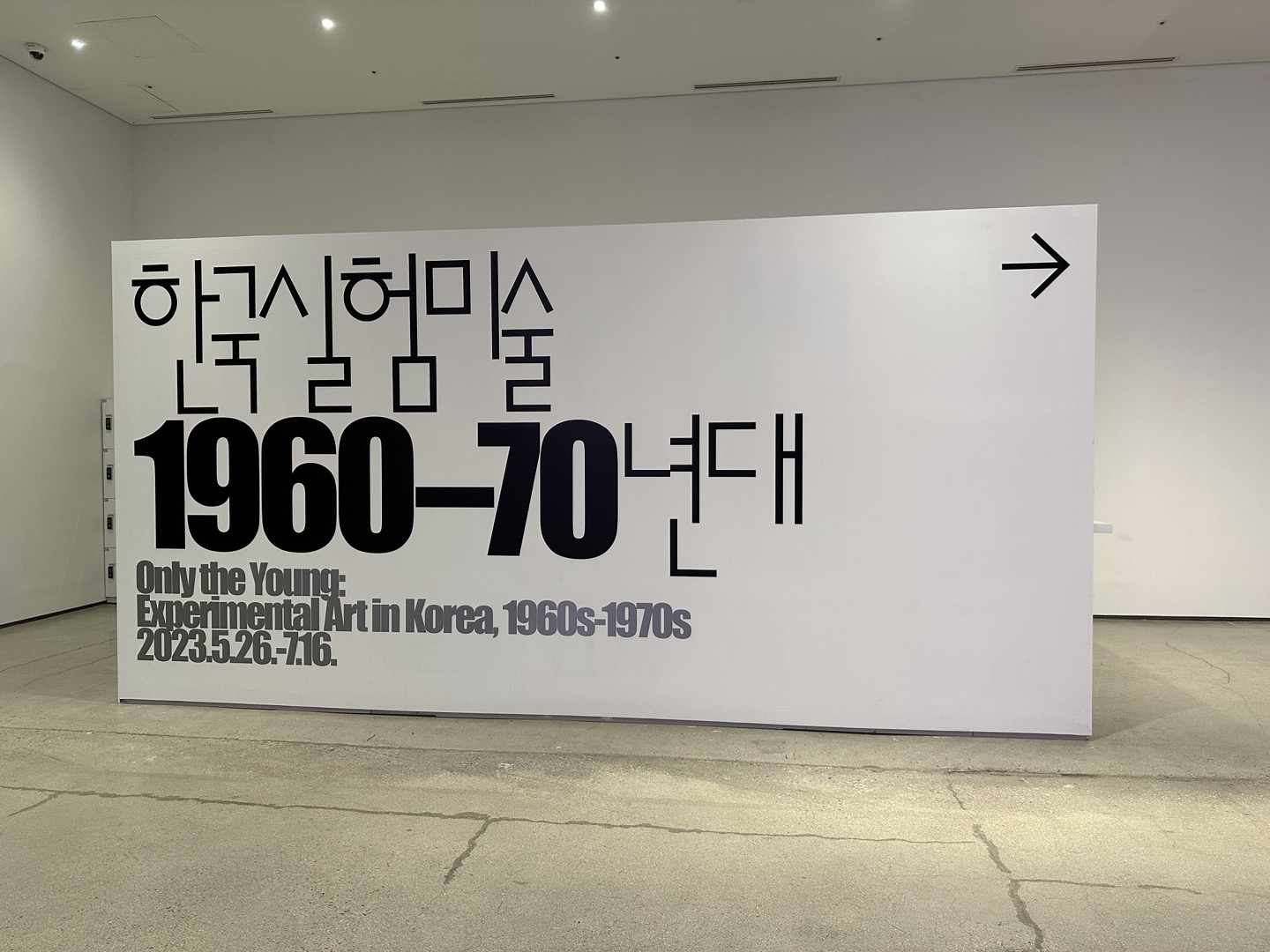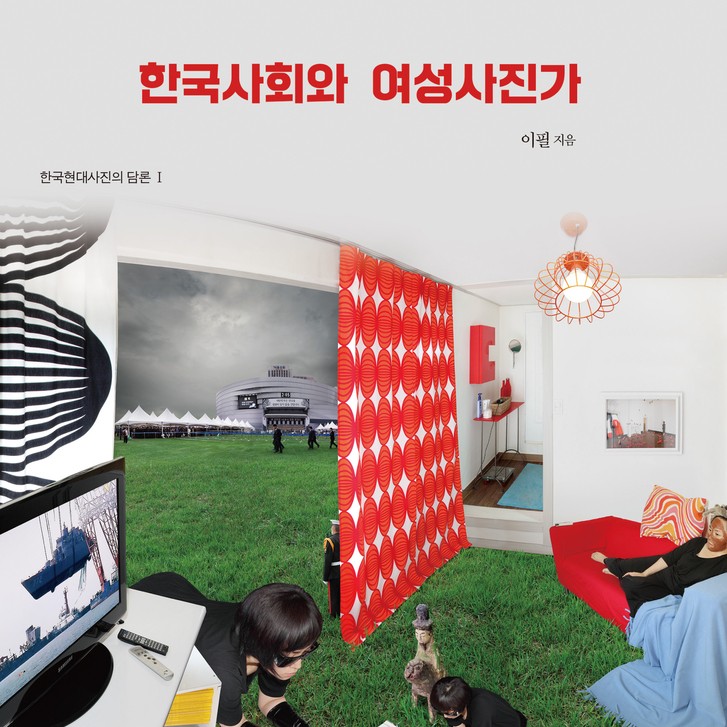Korean experimental art is driven by artists seeking to experiment and innovate and is comprised of attempts to overcome conventional art forms and experiences. In these attempts, artists have pushed the boundaries of convention and created original works, helping shape a culture that values artistic freedom and diversity.

Lee Kang-So, ‘Untitled-75031,’ 1975, Wood, Cock, Met, Plaster, Iron, Chalk, 9 Photographs and String, 25 x 350 x 350 cm.
The works of artist Lee Kang-So (b.1943) are recognized in the realms of experimental art and abstract painting. In the 1970s, he engaged in experimental work using various media through art activities, such as participating in groups like Shinchaeje (New Systems), and A.G., and joining the Daegu Contemporary Art Festival, and Seoul Contemporary Art Festival. He used his work to explore painting, printmaking, performance, photography, video, and installations.
Lee Kang-So began to gain attention in South Korea around 1973 when he held his first solo exhibition. Notably, his performance art piece titled Disappearance, Bar in the Gallery at the Myeongdong Gallery garnered significant recognition within the country. In this work, he created a makeshift pub with a table and chairs, making the space itself and the visitors’ integral parts of the artwork. Lee gained international recognition starting in 1975 when he participated in the 9th Paris Biennale. Instead of painting, he sprinkled flour on the floor, observed the natural behavior of a live cock in a chicken coop without intentionally manipulating its behavior, and presented the process in a performance titled Untitled-75031. This work received considerable international attention.
Today, Lee integrates traditional Eastern philosophies and artistic techniques into contemporary sculptural experiments, crafting works that naturally engage with viewers, creating art intuitively and organically within the frameworks he establishes.

Lee Kun-yong performing ‘The Method of Drawing,’ 1976. Photograph: Lee Kun-yong/The Asia Culture Centre.
Artist Lee Kun-Yong (b. 1942) was a prominent member of the Korean experimental art scene, notably associated with groups like A.G. and S.T. In particular, Lee, along with critic Kim Bokyoung, co-founded the S.T. group and led it until 1981. From the 1970s onwards, he concentrated on the concept that the artist’s body could serve as a medium for art through various forms of work, including performance, sculpture, installations, and video.
Lee subsequently became known for using his own body as a primary medium for art, expressing the body’s logic through his work. He primarily engaged in installation works centered around objets d’art. His perception of his body as a medium underwent a significant transformation when he participated in the 1973 Paris Biennale. Arriving in Paris after enduring various hardships to participate, he came to perceive his own body in an entirely new light. An avant-garde music concert held as part of the Biennale’s side event proved to be a pivotal event reinforcing this change in perception. At the concert, a live calf was involved in a performance, prompting the artist to initiate his own “events” utilizing his body as a medium.
To distinguish his work from coincidental happenings, Lee began to use the term “event” instead of “happening.” Unlike happenings, an “event” is an action that can be endowed with a certain logic, and the artist repeats the same action to eliminate randomness in his work. One of Lee’s signature series is Bodyscape, which has been ongoing since 1976. This series of drawings is not about portraying objects from nature or figures or expressing emotions on canvas; instead, he describes this series as a documentation of bodily acts governed by some inevitable logic. Through this approach, Lee has created a novel form of artistic expression.

Lee Seung-Taek, ‘Godret Stone,’ 1958, Stone, wood, rope, 85 x 188 cm
Artist Lee Seung-taek (b. 1932) has built a unique artistic identity centered around the concepts of “non-sculpture” and “anti-concept” by exploring traditional Korean culture and folk art. He creates works with everyday materials like vinyl and glass as art, and he extends the boundaries of sculpture by using non-material media such as smoke, fire, water, and wind. He has also utilized cultural and anthropological actions like binding, wrapping, burning, and flying fabric, which were not traditionally associated with sculpture.
Furthermore, he has aimed to overcome Western modern art, which had dominated the Korean art scene during the 1960s and 1970s, and establish a distinct identity for Korean contemporary sculpture by delving into Korean traditional culture, including folklore and shamanism. Starting in the 1960s, Lee Seung-taek sought to revive the neglected folk and shamanic aspects of Korean culture.
The concept of “non-sculpture” emerged with his two series Godret Stone and Wind. Godret Stone repurposed stones used to make matting in rural Korea to create a modern reinterpretation of traditional objects. This work laid the foundation for Lee Seung-taek’s later series of works known as Binding. In the Binding series, he carved hollows into rigid materials like stones and tied and wound ropes around them, seemingly transforming the stone’s hard properties into something soft in the process.
The Wind series, on the other hand, used shamanism as its motif to aesthetically express the spiritual energy of the Korean people. Lee Seung-taek visualized the invisible flow of air by tying colorful fabric or paper to tree branches, making it a prominent work within the genre of dematerialization art.
 Installation view of "Only the Young: Experimental Art in Korea, 1960s–1970s," Solomon R. Guggenheim Museum, New York. (September 1, 2023–January 7, 2024). Photo: Ariel Ione Williams. © Solomon R. Guggenheim Foundation.
Installation view of "Only the Young: Experimental Art in Korea, 1960s–1970s," Solomon R. Guggenheim Museum, New York. (September 1, 2023–January 7, 2024). Photo: Ariel Ione Williams. © Solomon R. Guggenheim Foundation.Korean experimental art emerged in response to changing societal conditions in the 1960s and 1970s. Young artists, feeling disillusioned with the established Art Informel, began seeking new artistic forms and drew influence from Western and Japanese art. However, they didn’t merely adopt foreign art; instead, they developed a distinctly Korean form of experimental art by considering the unique Korean context and circumstances. In particular, young Korean artists criticized existing institutions and generations, presenting experimental art in opposition to traditional art institutions like the Korean National Art Exhibition.
Various groups such as Origin Society, Mudongin (Zero Group), and Sinjeon dongin (New Exhibition Group) were actively involved in these efforts, and in 1967, they organized the Union Exhibition of Korean Youth Artists, further advancing Korean experimental art. This event led to the formation of important groups like the Korean Avant-Garde Association (A.G.) and Space & Time (S.T.), which consisted of many artists who used their works to raise societal awareness and stimulate social change on diverse topics, including politics, the environment, human rights, and social equality.
Korean experimental art has fostered creativity and provided artists with a space for free expression, contributing to diversity in contemporary Korean art. It has played a crucial role in conveying social messages by addressing a wide range of subjects. Korean experimental art has combined artistic innovation with societal impact, earning recognition as one of the country’s most noteworthy art phenomena both domestically and internationally.






























